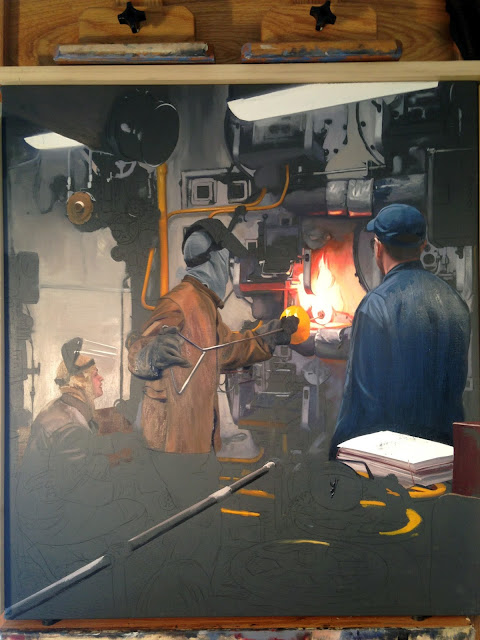On September 15th, I was able to see a few more spots on the ship, several of which relate to one of the main functions of the LHD platform: Aviation.
It's key, when wanting to project power overseas, that the aviation assets on board a warship are a well-oiled machine. The ACE, or "Aviation Combat Element" consists of the squadron or squadrons of aircraft, fixed- and rotary-wing, that live on and fly missions from the ship. The ACE lives to support the other main element in the MEU: the troops on the ground-- also called the GCE, or "Ground Combat Element."
Everything must function smoothly, from aircraft maintenance in the hangar bay to controlling the aircraft movement on the flight deck, to getting the aircraft off the ship and out on their missions. These activities are divided into several sections on the ship: two major ones being Flight Deck Control, and Primary Flight Control, two of the places I got to visit and sketch.
Flight Deck Control means exactly what it sounds like: control of the flight deck. It's where all the aircraft are managed and moved on the flight deck itself, and from the hangar bay and elevators.
Flight Deck Control
Primary Flight Control, or "Pri-Fly," (also known as the "Tower") is where all the aircraft are controlled from the moment the depart the deck of the ship until they're out into the airspace.
"Pri-Fly," or Primary Flight Control.
Another view of the Air Boss in Pri-Fly on USS Bataan
Of course, all of this activity centers around one of the most important and often times most chaotic bits of real estate on the ship: the flight deck itself. All sorts of aircraft, equipment, and personnel call the flight deck home, and the deck crews assist Pri-Fly and Flight Deck Control in getting the aircraft off of (and safely back on!) the deck.
Deck Crewman AM3 Chyrsten Morrell with fire extinguisher ("Fire Bottle") waiting for the aircraft to land on the flight deck of USS Bataan.

Another view of the "Fire Bottle" AM3 Morrell...
Deck crewmen await the landing of the "birds" ( Helos and Ospreys)...
SH-60 Sea Hawk after having landed on the flight deck of USS Bataan September 15th, 2016
Osprey of VMM-365 during flight ops on the flight deck of USS Bataan September 15th, 2016










































